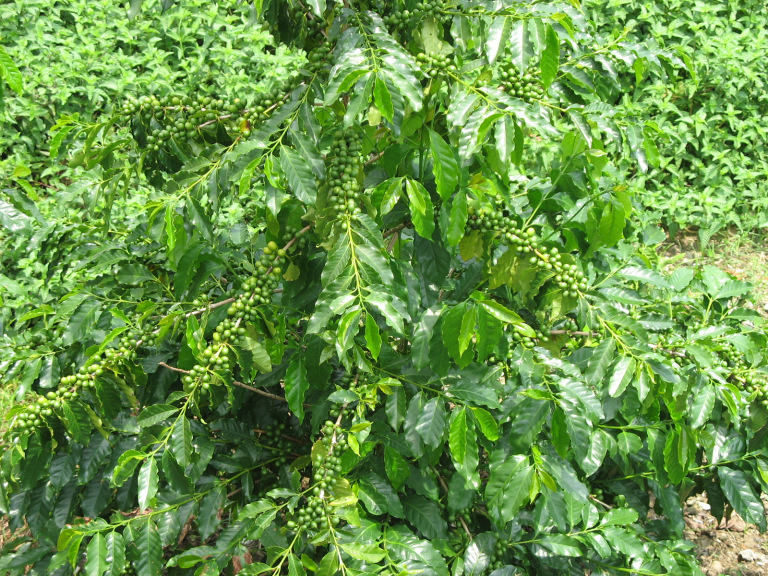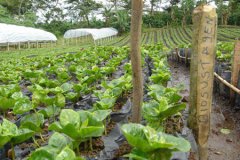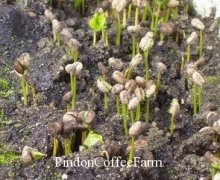Can coffee trees be planted at home? let's first understand the whole process of coffee beans from planting to picking!

Professional coffee knowledge exchange more coffee bean information please follow the coffee workshop (Wechat official account cafe_style)
What are the fruits and seeds of coffee? What the coffee beans look like.
Want to plant coffee trees in your own home? Let's take a look at the whole process of coffee beans from planting to picking:
The growth process of coffee
Seedling stage
The seedling stage is a period from the germination of seeds (or cuttings, grafting) to the emergence of seedlings (the stage of raising seedlings in the nursery), about 0.5-1.5 years. After the coffee seeds were sown, the cotyledons began to be unearthed after a period of germination, which took about 30-100 days, and the length of time was closely related to temperature and humidity. After germination, the cotyledon seedlings should be transferred to a nutrition bag to raise seedlings, which takes 3-12 months to get out of the nursery.
KONICA MINOLTA DIGITAL CAMERA
Young tree stage
The young tree period refers to the period from planting to putting into production, about 2-3 years. The main feature of this period is exuberant vegetative growth, which can draw 6-8 pairs of branches every year, centering on the growth of roots, stems and leaves, and the aboveground and underground parts expand rapidly to form an ideal plant structure in preparation for production.
2006112415435909
Birth period
The first production period refers to the period from the beginning of production to the advent of high production, during which coffee begins to enter into reproductive growth, coffee trees grow vigorously, and there is a great demand for nutrients.
07050612
High-yield period
About 1-2 years after the first birth period, the coffee tree enters its peak period. The coffee tree usually blossoms for 3-4 years, about 2-3 months a year. Its appearance and smell are similar to those of jasmine. When it blossoms, it grows in clusters on the branches and florescence for 5 days. After the flowers bloom, they bear small green fruits, which ripen and turn red into ripe fruits that can be picked after a few months.
The skin of ripe fruit is red. Because its shape and color are similar to cherries, ripe coffee fruit is called coffe cherry in many places. Under the bright red pericarp, the peel, pulp and a sweet sticky yellow substance wrap the coffee beans.
Proper management can last about 30 years.
five
Aging period
The growth is declining year by year, the economic life is nearing the end, and the coffee tree indicates that it is entering a period of aging. Its life span is closely related to climate, soil and management level, and there are still century-old coffee trees that can blossom and bear fruit.
Planting conditions
The origin of the coffee tree is Ethiopia in Africa. In botany, coffee trees belong to the evergreen trees of the subgenus Rubiaceae, and coffee beans, commonly known as coffee beans, are the seeds of the fruit of coffee trees, just because they are shaped like beans, so they are called coffee beans.
Climate is the decisive factor for coffee cultivation. Coffee trees are only suitable for growing in the tropics or subtropics, so the zone between latitude 25 degrees south and north is the most suitable for growing coffee. This coffee production zone is generally referred to as "coffee belt" or "coffee area".
However, not all the land located in this area can cultivate good coffee trees. The ideal planting conditions for coffee trees are: a warm climate with a temperature of 15-25 ℃, and a rainfall of 1500-2000 mm throughout the year, and the rainfall time should be consistent with the flowering cycle of the coffee tree. Of course, in addition to the coordination of seasons and rainfall, there should be fertile soil. The most suitable soil for growing coffee is a well-drained, fertile soil containing volcanic ash.
Coffee belt: coffee can not be grown in any environment, because it is originally a plant growing in a tropical rain forest, and in phylogeny, it forms the habit of requiring calm wind, cool, shaded or semi-shaded and humid environment.
Temperature: the temperature requirements vary with the cultivated species. Small seed species are more hardy and prefer a warm and cool climate, requiring an annual average temperature of 19 Murray 21 degrees.
Rainfall: annual rainfall of more than 1250 mm, uniform distribution, especially in the flowering and small fruit development period, there is a certain amount of rainfall is most suitable for the growth and development of coffee.
Light: coffee trees are not resistant to strong light and need proper shade. The light is too strong and their growth is inhibited. If you add in the lack of water and fertilizer, there will be premature senility and even death. The shade is excessive, the branches and leaves are too long, the flowers and fruits are scarce and the yield is very low.
Wind: coffee likes a quiet breeze.
Soil: coffee tree has well-developed roots, shallow distribution of absorbing roots, and requires loose, fertile and well-drained loam.
Most of the coffee harvesting in the world is selected by hand, so it is a labor-intensive and seasonally intensive process. Since there are both flowers and fruits on the same branch, the index finger and thumb of the collector are the best tools for collecting ripe berries. Scraping the fruit off a whole branch by hand or using an automated harvester can't tell ripe berries from green berries.
Coffee farmers who produce low-grade coffee beans like to use labor-saving methods to harvest beans, but in this way, because the quality is not pure, it impairs the flavor of coffee and lowers the grade of coffee. The way to pick coffee beans in some parts of Africa is to shake coffee trees, shake the fruit off the ground, and pick it up from the ground before the fruit is injured and rotten. Secondary coffee is produced in most parts of Brazil, where coffee is picked by plucking all the leaves, flowers, overheated and green fruits from the branches at a time, and it takes two years for such damaged coffee trees to return to normal.
DSC00090
Fruit anatomy
These five layers are:
1. Skin/Pulp: the outermost layer of coffee beans is covered with berry-like skin and pulp. In addition to the natural sun method, coffee beans treated by other methods must remove the skin and flesh within a few hours after picking. For coffee, peel and pulp are important by-products. In some places, people use the peel and pulp of coffee to make tea. People in the industry are accustomed to calling the skin and pulp of coffee "Pulp", while the machine used to remove the pulp is called "desizing machine".
two。 Mucous membrane (Mucilage): under the peel and pulp, a thick layer of mucus tightly wraps the coffee beans. Because this mucous membrane is extremely sticky and high in sugar, it is used to call it "Honey". Not only coffee, but also many fruits have a layer of mucus inside.
3. Parchment (Parchment): inside the mucous membrane, a thin film of cellulose surrounds the coffee beans. After drying, the film looks like parchment, hence the name.
4. SilverSkin/Chaff: there is a thinner film inside the parchment that wraps the coffee beans. Because the color is glossy and silvery, people used to call it "silver skin". This layer of silver will fall off during baking. Usually when you grind the coffee, you find some silver crumbs in the coffee powder. These crumbs are the silver skins that fail to peel off the coffee beans during baking.
5. Coffee beans: each fruit contains 2 coffee beans (except for a single pod bean Peaberry. The fruit of this kind of coffee contains only one coffee bean. Normally, 5% of each batch of coffee beans is a single pod. Coffee beans can be roasted after drying and processing.
.
Important Notice :
前街咖啡 FrontStreet Coffee has moved to new addredd:
FrontStreet Coffee Address: 315,Donghua East Road,GuangZhou
Tel:020 38364473
- Prev

Common sense of Coffee Tree planting Coffee how to grow Coffee and where is it suitable to grow Coffee in China
Professional coffee knowledge exchange more information about coffee beans Please follow the coffee workshop (Wechat official account cafe_style) what are the fruits and seeds of coffee? Coffee trees grow in the tropics between Tropic of Cancer and Tropic of Cancer and near the equator, also known as the world coffee growth belt, caffeine varieties and regional factors.
- Next

Can I grow coffee in China? Technical record of Seedling, planting and Shade cultivation in Qianjie Coffee Plantation
Professional coffee knowledge exchange more information about coffee beans Please follow the coffee workshop (Wechat official account cafe_style) what are the fruits and seeds of coffee? What the coffee beans look like. Nursery preparation: attention should be paid to shading effect in nursery selection. Seedlings exposed to direct sunlight are easy to die and reduce the survival rate. Therefore, the nursery must have shading equipment, shading materials can
Related
- Beginners will see the "Coffee pull flower" guide!
- What is the difference between ice blog purified milk and ordinary milk coffee?
- Why is the Philippines the largest producer of crops in Liberia?
- For coffee extraction, should the fine powder be retained?
- How does extracted espresso fill pressed powder? How much strength does it take to press the powder?
- How to make jasmine cold extract coffee? Is the jasmine + latte good?
- Will this little toy really make the coffee taste better? How does Lily Drip affect coffee extraction?
- Will the action of slapping the filter cup also affect coffee extraction?
- What's the difference between powder-to-water ratio and powder-to-liquid ratio?
- What is the Ethiopian local species? What does it have to do with Heirloom native species?

